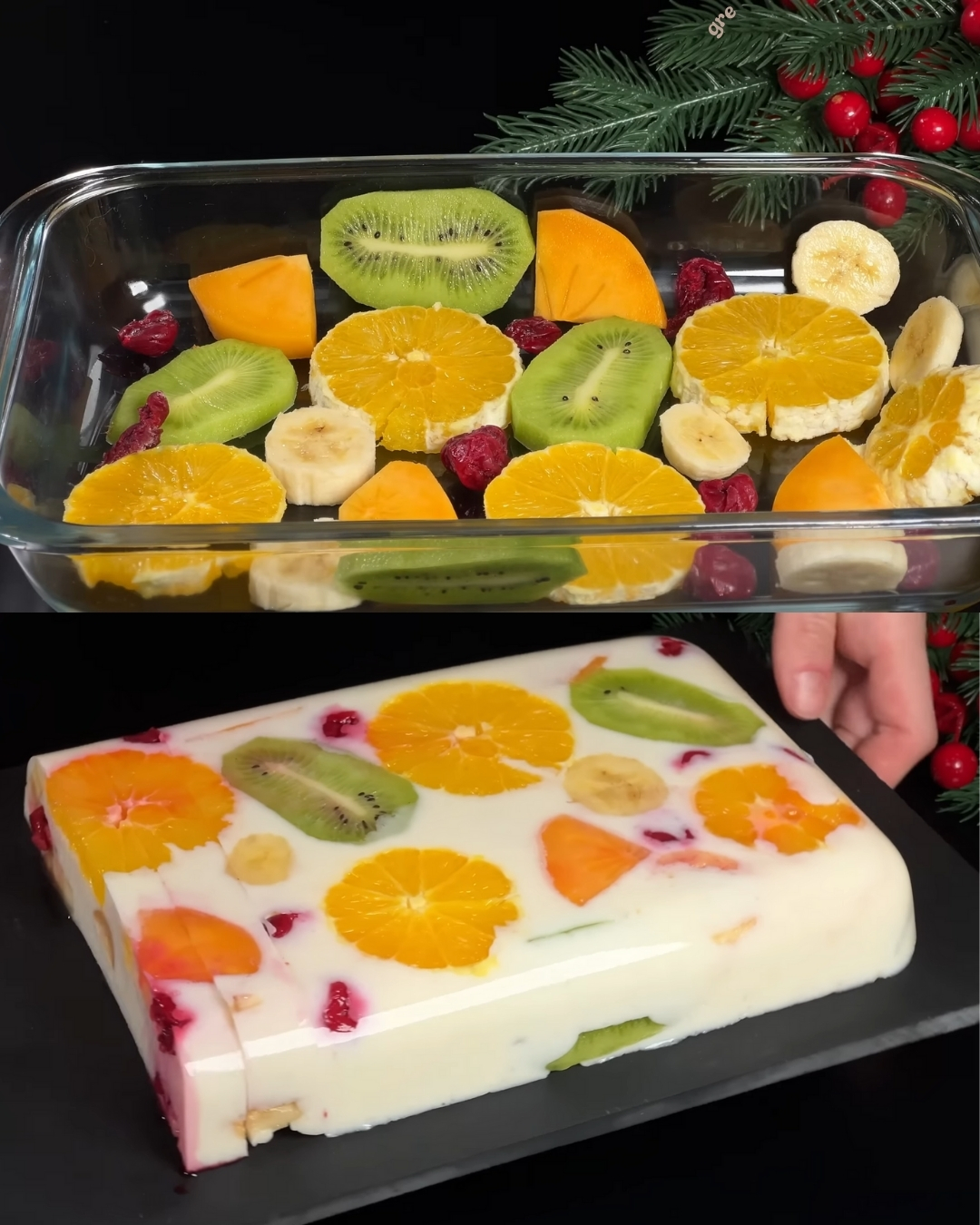If you’re looking for a light, beautiful, and refreshingly fruity dessert, this Agar-Agar Milk Jelly with Mixed Fruit Medley is just what you need. Made with creamy milk, sweetened condensed milk, and firm-setting agar-agar, this dessert is naturally gluten-free, egg-free, and customizable with your favorite fruits. The combination of vibrant seasonal fruits like orange, kaki (persimmon), banana, kiwi, grapes, and cherries not only makes it visually stunning but also adds a burst of fresh flavor and nutrition. Perfect for summer parties, family dinners, or a festive holiday table, this jelly dessert is both elegant and easy to make.
Cooking Time
-
Preparation Time: 15 minutes
-
Cooking Time: 10 minutes
-
Chilling Time: 2–3 hours
-
Total Time: 2 hours 25 minutes
-
Servings: 8
Ingredients
-
10 g agar-agar powder
-
70 ml water (to dissolve agar-agar)
-
500 ml milk (preferably whole milk)
-
350 g sweetened condensed milk
-
1 orange, peeled and segmented
-
1 kaki (persimmon), peeled and sliced
-
1 banana, sliced
-
1–2 kiwi, peeled and sliced
-
A handful of frozen cherries
-
A handful of grapes, halved and seedless
Step-by-Step Cooking Directions
1. Prepare the Agar-Agar Mixture
-
In a small saucepan, mix 10 g agar-agar powder with 70 ml of cold water. Stir to combine and let it bloom for 5 minutes.
2. Heat the Milk Mixture
-
In a separate pot, heat 500 ml milk over medium heat.
-
Add 350 g condensed milk and stir continuously until well combined. Do not bring to a full boil—just heat until hot and steamy.
3. Dissolve the Agar-Agar
-
Place the bloomed agar-agar mixture over medium heat. Stir constantly and bring to a gentle simmer.
-
Once the agar is completely dissolved and no granules remain (around 2–3 minutes), pour it into the hot milk mixture and stir well.
-
Keep stirring for 2 more minutes to ensure everything is well incorporated, then remove from heat.
4. Prepare the Fruit Layer
-
While the milk jelly is cooling slightly, arrange the fruit in a large mold or small serving cups.
-
Add slices of orange, kaki, banana, kiwi, grapes, and a few frozen cherries. Be creative with the design!
5. Pour the Jelly Mixture
-
Carefully pour the warm (not hot) milk-agar mixture over the fruit.
-
Let it sit at room temperature for 10–15 minutes, then transfer to the refrigerator.
6. Chill and Serve
-
Chill for at least 2 hours, or until fully set.
-
To unmold, dip the mold briefly in warm water and invert onto a plate.
-
Serve chilled and enjoy the creamy, fruity delight.
Nutritional Information (Per Serving)
-
Calories: 170 kcal
-
Protein: 5 g
-
Carbohydrates: 28 g
-
Fat: 4 g
-
Fiber: 2 g
-
Sugar: 22 g
-
Calcium: 150 mg
The Origins and Popularity of the Recipe
Agar-based milk jelly desserts have deep roots in Asian cuisines, particularly in Japanese and Southeast Asian households. Known for their firm texture and clear layers, agar jellies are widely used in vegan and vegetarian diets as a plant-based alternative to gelatin. In recent years, agar desserts have gained popularity worldwide thanks to their versatility, beautiful appearance, and adaptability to seasonal fruits and flavors. Combining dairy with tropical fruits adds a creamy touch to this otherwise light and refreshing treat.
Reasons Why You’ll Love the Recipe
-
Visually Stunning: Layered fruits inside a creamy jelly are always a showstopper.
-
No Gelatin Needed: 100% plant-based thanks to agar-agar.
-
Low Effort, High Reward: Minimal cooking and prep with amazing results.
-
Customizable: Use your favorite seasonal fruits or even canned ones.
-
Great for All Ages: Light, not too sweet, and appealing to kids and adults alike.
Health Benefits
-
Agar-Agar is rich in fiber and supports digestive health.
-
Milk provides calcium, vitamin D, and protein.
-
Fruits like kiwi, oranges, and persimmons are rich in vitamins C, A, and antioxidants.
-
Bananas and grapes offer natural sweetness and potassium.
-
Cherries add a touch of tartness and are packed with anti-inflammatory compounds.
Serving Suggestions
-
Serve chilled with an extra fruit garnish on top.
-
Slice into cubes and serve in individual cups for parties.
-
Add a drizzle of fruit syrup or honey before serving for added sweetness.
-
Pair with tea or lemonade as a light dessert after meals.
Common Mistakes to Avoid
-
Not fully dissolving the agar-agar: This leads to a grainy texture. Always dissolve completely.
-
Pouring jelly mixture while too hot: It can cook the fruit or cause discoloration. Let it cool slightly.
-
Using watery fruits like watermelon: They may release liquid and affect the set.
-
Adding acidic fruits directly to hot agar mix: This can prevent proper setting. Let everything cool.
-
Skipping bloom time: Agar-agar needs to soak before heating to activate its gelling power.
Pairing Recommendations
-
Drinks: Serve with herbal tea, iced green tea, or sparkling citrus water.
-
Main Course: Pairs well after light meals like grilled fish, rice bowls, or noodle dishes.
-
Other Desserts: Serve alongside mochi, custards, or fresh fruit salad for a variety platter.
-
Garnishes: Try a mint leaf, citrus zest, or a light dusting of shredded coconut.
Cooking Tips
-
Use silicone molds for easy release.
-
Want a two-tone effect? Pour half of the jelly mixture, let it set slightly, then add more fruit and the rest of the mixture.
-
Add a drop of vanilla or almond extract for extra flavor.
-
Chill individual portions in glass cups for elegant single servings.
-
Make it vegan by using plant-based milk like almond, oat, or soy.
Similar Recipes to Try
-
Coconut Milk Agar Jelly with Lychee
-
Mango Pudding with Chia Seeds
-
Strawberry Milk Jelly Cups
-
Thai Fruit in Coconut Jelly
-
Vanilla Panna Cotta with Berry Compote (gelatin-based)
Variations to Try
-
Chocolate Twist: Add 1 tbsp cocoa powder to the milk mixture.
-
Tropical Mix: Use mango, pineapple, and passion fruit instead of temperate fruits.
-
Layered Version: Chill half the jelly, then layer with fruit puree before adding more jelly.
-
Vegan: Use oat or almond milk and maple syrup instead of condensed milk.
-
Spiced: Add cinnamon, nutmeg, or cardamom to the milk for a warm twist.
Ingredient Spotlight: Agar-Agar
Agar-agar is a natural gelling agent derived from red seaweed. Unlike gelatin, which is animal-based, agar is plant-based, making it perfect for vegetarian and vegan recipes. It sets more firmly and does not melt as easily at room temperature. In this dessert, agar gives structure to the milk and fruit, allowing you to create beautifully molded treats with a light bite and smooth finish.
Conclusion Paragraph
This Agar-Agar Milk Jelly with Mixed Fruit is the perfect dessert when you want something beautiful, delicious, and refreshing. With its creamy base, bursts of sweet fruit, and lightly chewy texture, it’s a treat that satisfies both your eyes and your taste buds. Whether you’re serving it at a family dinner, bringing it to a potluck, or just making something special for yourself, this easy, no-bake dessert is bound to impress. Light, elegant, and customizable—it’s everything you need in a crowd-pleasing sweet dish.
Frequently Asked Questions (FAQs)
1. Can I use gelatin instead of agar-agar?
You can, but gelatin sets differently and is not vegetarian. You’ll need to adjust quantities and chill longer.
2. How long does it take to set?
Agar sets within 1–2 hours in the refrigerator. It firms up faster than gelatin.
3. Can I use other fruits?
Absolutely! Berries, mango, pineapple (cooked), or even canned fruit all work.
4. Is this dessert vegan?
Not by default due to the condensed milk, but you can substitute with plant-based milk and a vegan sweetener.
5. Can I make this in advance?
Yes! It keeps well in the fridge for 3–4 days. Cover to prevent drying out.
6. Why didn’t my jelly set?
Agar may not have fully dissolved, or the ratio was incorrect. Be sure to simmer it thoroughly.
7. Can I freeze this jelly?
Freezing changes the texture. It’s best served fresh or refrigerated only.
Advertisement
8. Is it overly sweet?
Not at all. The sweetness comes mostly from condensed milk and fruit, but you can adjust to your taste.
9. How do I prevent the fruit from floating?
Let the jelly cool slightly so it begins to thicken before pouring it over the fruit.
10. Do I need a special mold?
No, you can use any dish, silicone mold, or even small cups or jars.

